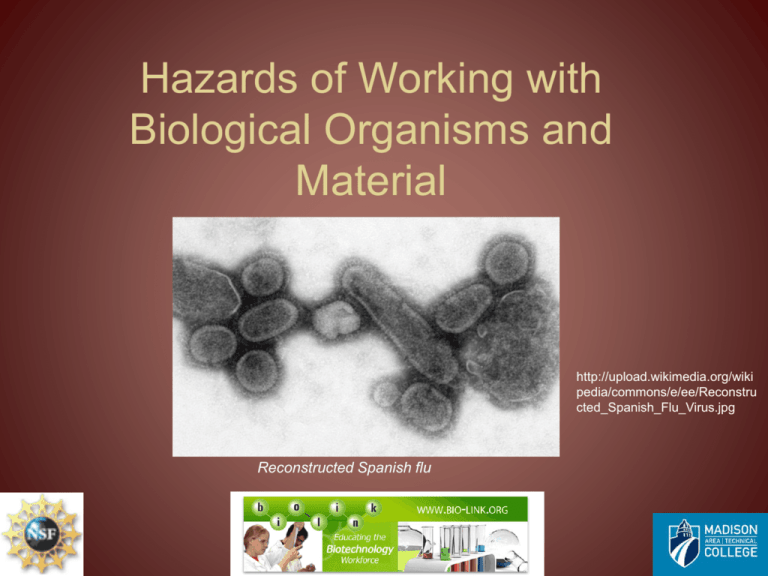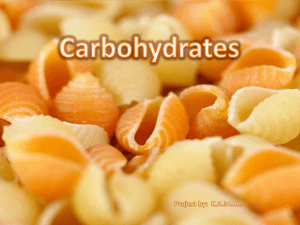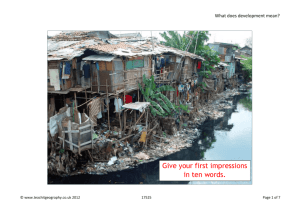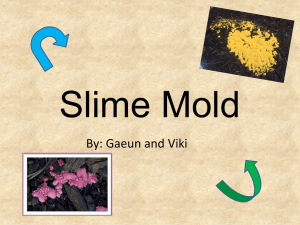PowerPoint
advertisement

Hazards of Working with Biological Organisms and Material http://upload.wikimedia.org/wiki pedia/commons/e/ee/Reconstru cted_Spanish_Flu_Virus.jpg Reconstructed Spanish flu Working with Fungi • Fungi and molds everywhere – Mycosis • disease caused by infection – Toxicity • from mycotoxins – Allergies • airborne spores Photo: Adrian J. Hunter http://en.wikipedia.org/wiki/File:Four_3day_old_Aspergillus_colonies_on_a_Petri_dish.png Hazards of Working with Viruses • Integration of viral genome http://www.edidik.com/wpcontent/uploads/2010/09/hiv_biology.gif Calculating Risk Level • Viruses differ in infectiousness Hepatitis B virions http://en.wikipedia.org/wiki/File:Hepatitis-B_virions.jpg Calculating Risk Level • Different viruses have different consequences – HBV causes Hepatitis B – HIV causes AIDS • Treatment or vaccine? Viruses and Cancer • Some viruses are oncogenic • Moderate risk viruses – Include: papilloma virus, herpes virus, Epstein-Barr virus, and the Hepatitis B and HPV http://upload.wikimedia.org/wikipedia/commons/c/c4/Papilloma_ C viruses Virus_(HPV)_EM.jpg Working with Human Blood Products “Universal Precautions” – Minimizing use of needles and sharps and proper disposal of these – Wearing PPE – Decontaminating all work surfaces frequently – Decontaminating waste – Frequent hand washing – Biohazard sign posting Working with Tissue Culture • Tissue culture = in vitro propagation of cells taken from tissue of higher organism http://ibnulhaithemsciences.com/Images/Cell _Culture_Mgt.jpg http://www.sydneyg enetics.com/Portals /4/fibroblasts%20ph ase%20contrast.JP G Primary Cell Culture – Newly isolated cells from tissue or blood – Can be infectious Note cells migrating from piece of tissue http://usm.maine.edu/toxicology/images/nmcl8.jpg Established cell lines – Many generations in culture – Less likely to pose unknown threat Cultured HeLa cells http://upload.wikimedia.org/wikipedia/co mmons/6/6c/HeLa_cells_stained_with_H oechst_33258.jpg Disposal of Biohazardous Waste Biohazard waste – Discarded cultures of bacteria or cell culture – Out of date stock cultures – Human and animal waste – Used culture dishes and tubes – Biologically contaminated sharps Disposal – Place in labeled, closable, leak-proof bags – Place bags in secondary containers to prevent punctures – Usually decontaminate by autoclaving Routine Clean-up: Disinfection • Removal of all or almost all pathogens on a surface http://www.tristel.com/images/duo_laboratory_surface_disinfectant_sml.jpg Disinfectant Characteristics Chemicals that kill pathogenic microorganisms and other hazardous particles Ideal: – – – – Broad spectrum Water-soluble Low toxicity Inexpensive No ideal disinfectants Factors affecting the effectiveness of disinfectants – Type of organism • Least resistant: viruses like HIV, Herpes and Hepatitis B • Then Bacteria • Then Fungi • Then small viruses like polio and rhinoviruses • Most resistant are bacterial spores Bacterial spore http://today.uchc.edu/images/features/photo_spore.jpg Disinfectants • Effectiveness also affected by – Level of contamination – Chemical composition and concentration of disinfectant – Length of exposure to disinfectant – Texture of surface to be disinfected Choosing disinfectants • Low— – gets rid of most bacteria and SOME viruses and fungi – used for routine clean-up and decontamination http://upload.wikimedia.org/ wikipedia/commons/9/93/Ag ar_plate_with_colonies.jpg • Intermediate— – gets rid of most bacteria, viruses and fungi – Not spores – includes phenolics and 500 ppm chlorine bleach – used for clean-up of bodily fluids http://upload.wikimedia.org/wikipedia/commons/2/24/Red_White _Blood_cells.jpg Choosing disinfectants • High— – gets rid of all microorganisms except large number of bacterial spores – included H2O2 and 1000 ppm chlorine bleach – used for instruments that can not be autoclaved Bacillus anthracis containing spores (anthrax) • http://uploa d.wikimedi a.org/wikip edia/comm ons/1/12/B acillus_ant hracis.png Sanitization • General reduction of number of microbes on surface – antiseptic http://www.tradenote.net/images/users/000/360/463/products_im ages/Antibacterial_Hand_Soap.jpg Sterilization • Killing of all organisms on a surface Autoclave http://upload.wikimedia.org/wikipedia/commons/4/44/ExampleAut oclave.jpg Biohazard spills For personal contamination – Remove all contaminated clothing and soak lab coats in bleach prior to washing – Wash skin areas vigorously for at least 10 minutes – Use an antiseptic if available – Inform supervisor immediately Biohazard Spills • For a small spill with a BSL-1 or BSL-2 organism – Wear protective clothing – Soak up spill with absorbent towels soaked in disinfectant (ie 10% bleach) – Dispose of towels in biohazard waste – Clean spill area with fresh towels and disinfectant http://www.enware.com.au/Images/Us erUploadedImages/102/ZEOBZ001%20-%2072dpi%20800px.jpg Biohazard spills For a BSL-2 organism: – First evacuate for 10 min. to let aerosols settle – Cover main spill area with towels soaked in disinfectant. Then flood secondary area with disinfectant. – Place all waste in biohazard bags. – Put additional disinfectant over spill area and let sit for at least 20 minutes for decontamination.







